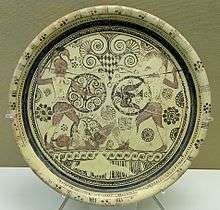Euphorbos plate

The Euphorbos plate is the name of an East Greek plate with mythological painting in the Orientalising style.
The Euphorobs plate depicts a duel between two warriors of the Trojan War, the Greek Menelaos and the Trojan Hector. At their feet lies Euphorbos, mostly nearer to Menelaos, which indicates that the latter is winning the duel. The scene depicts one of the most important moments of the war. After the raging Achilles had withdrawn from battle, his best friend Patroklos, wearing Achilles' armour, took his place in battle. He was killed by Euphorbos, who was himself killed by Menelaos. In the Iliad, Menelaos gets away with the physical remains and armour of Euphorbos in the subsequent battle, as depicted on the plate. Thus this scene is a new interpretation or is based on a different version of the story.
The plate has a diameter of 38 centimetres. It is a "Rhodian plate" (named for the place where most examples were made, including the Euphorbos plate itself). The Euphorbos plate is one of the few examples of the type which shows a mythological scene. The plate belongs to the middle Wild Goat Style. The plate is dated to c.600 BC. It was found at Kameiros and is now in the British Museum.[1]
References
| Wikimedia Commons has media related to Euphorbos-Teller. |
- ↑ Inventory number 1860.4-4.1.
Bibliography
- Thomas Mannack: Griechische Vasenmalerei. Eine Einführung. Theiss, Stuttgart 2002, ISBN 3-8062-1743-2, p. 94.